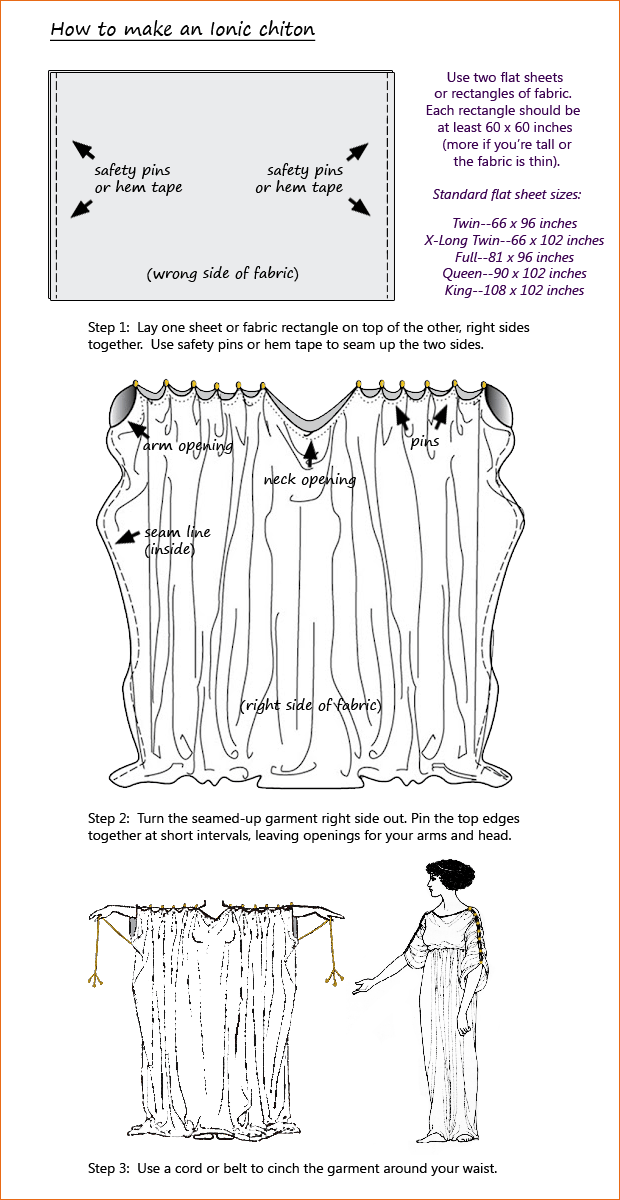 |
| It's me! Hi! |
I can has Roman! Our upcoming fall baronial event is Byzantine-themed, and folks are dragging out all the Byz and Roman they can muster. It was the perfect excuse to make this outfit - which I'd had the fabric for set aside, no kidding, for like two years, and never got around to throwing together.
My friend Simona and I got together last weekend to brainstorm styling and draping. She saved us both from toga-party snoredom with an ingenious pattern idea that she [edit: learned from a woman who'd learned the method at a King's College (Ansteorra) class taught by Cherie Weed, a local SCA seamstress].
The dress is cotton "bubble" gauze, the sash is made from scraps of blue silk (leftover from this cotehardie), and the palla - the black drape over my head and shoulders - is a soft, loosely-woven curtain panel of cotton that was given to me many years ago.
"But wait," you say, "isn't Roman 'garb' just a bunch of big rectangles pinned/sewn together?" That's exactly what this is...but not in the way that I thought it would be.
 |
| This is Simona, and her new teal linen Roman outfit. ♫ H-h-h-hiiii, Simona! ♫ |
At the simplest level, two rectangles of fabric pinned at the shoulders makes a peplos, like this:
 |
| (Pinterest, credited to "scaeveryday", tho I couldn't find a direct link). |
Or a single swath of fabric, wrapped from one side and pinned at the shoulders and down the arms, gets you a chiton, like this:
 |
| (Take Back Halloween. This example is also sewn down the sides, but it doesn't have to be) |
Simona's pattern, though, goes a little something like this:
A tube is sewn, with the seams in the front and back of the body, instead of on the sides. The top front and back are opened to create the V-shaped neckline, and then gathered (about 4-7", depending on how drapey and pleat-y you want the finished garment)/ This part rests on your shoulders, and your arms go through the resulting sleeve holes.
This method gives a really lovely drape across the neckline and bust, and is very form-flattering. I regret that I don't have any documentation to provide for research purposes; as I said, Simona learned this in a class - which had resource information, but we don't have access to those materials at this time. (If I DO find any, I'll update here).
The only example of this patterning I could find online was from this picture on Pinterest, but the link doesn't go anywhere, sadly:
 |
| (Pinterest) |
In this example, the shoulder pieces have been wrapped instead of gathered. I rather like that look. It also looks like the seams here might be on the sides, and open at the bottom, and that the front may have simply been slit open (much like you do with this knit dress pattern, of which I've made several, by the way, and they're wonderful to wear!) and then pinned in place.
So there you go. :) I'm working on some jewelry at the moment; I'll put up pics as soon as I'm finished. And find my camera data cable. 0_0
.

That is fantastic...it would be great for a cosplay Idea I have. I'll give you a clue. Doctor Who (Fires of Pompeii)
ReplyDeleteYou know this caused me to fall down a pintunnel...
ReplyDeleteIf I could attach a picture I'd show you documentation for this dress - very cute! I've been trying to figure out how to make this dress - thank you!
ReplyDeleteWanted to thank you for posting this. It's great. I hope you're able to get documentation for it, as I'd LOVE to see it. How big is your palla?
ReplyDeleteHere's one that looks right https://commons.wikimedia.org/wiki/File:Woman_khiton_himation_GR1875.10-12.10.jpg
ReplyDeletethis one is possible, too http://rubens.anu.edu.au/htdocs/bycountry/germany/berlin/museums/altesmuseum/ceramics/greece/tanagra/229.JPG
ReplyDeleteand another https://www.pinterest.com/pin/306174474682509237/
ReplyDeleteOh my 'lanta, I love this!! This is definitely going on my list for the next Roman garb I make. And if you look at a variety of Roman busts and statues you can see bust draping like this! So cool, thank you so much!
ReplyDelete